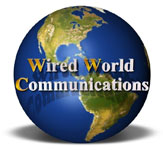Fiber Optic Solutions
 Wired World Communications Inc. excels at fiber network design, WWC can install Ariel, burial fibers. Fiber optics (optical fibers) are long, thin strands of very pure glass about the diameter of a human hair. They are arranged in bundles called optical cables and used to transmit light signals over long distances. Fiber networks provide clear data transmission and high bandwidth at a cost savings. Our skilled Fiber installation experts can meet any need, whether it be indoor plant applications or outdoor direct burial Fiber. All installations are marked with Fiber Optic awareness labels to insure safety of employees and your network.
Wired World Communications Inc. excels at fiber network design, WWC can install Ariel, burial fibers. Fiber optics (optical fibers) are long, thin strands of very pure glass about the diameter of a human hair. They are arranged in bundles called optical cables and used to transmit light signals over long distances. Fiber networks provide clear data transmission and high bandwidth at a cost savings. Our skilled Fiber installation experts can meet any need, whether it be indoor plant applications or outdoor direct burial Fiber. All installations are marked with Fiber Optic awareness labels to insure safety of employees and your network.
The Fiber Optic Advantage, Why are fiber-optic systems revolutionizing telecommunications? Compared to conventional metal wire (copper wire), optical fibers are:
Networking Soloutions
![155px-Dell_logo.svg[1]](http://www.wwclondon.com/newtest/wp-content/uploads/2012/10/155px-Dell_logo.svg1_.png) Dells Switches Hubs and routers with Fiber Optic tranceivers
Dells Switches Hubs and routers with Fiber Optic tranceivers
Less expensive – Several miles of optical cable can be made cheaper than equivalent lengths of copper wire. This saves your provider (cable TV, Internet) and you money.
- Thinner – Optical fibers can be drawn to smaller diameters than copper wire.
- Higher carrying capacity – Because optical fibers are thinner than copper wires, more fibers can be bundled into a given-diameter cable than copper wires. This allows more phone lines to go over the same cable or more channels to come through the cable into your cable TV box.
- Less signal degradation – The loss of signal in optical fiber is less than in copper wire.
- Light signals – Unlike electrical signals in copper wires, light signals from one fiber do not interfere with those of other fibers in the same cable. This means clearer phone conversations or TV reception.
 Low power – Because signals in optical fibers degrade less, lower-power transmitters can be used instead of the high-voltage electrical transmitters needed for copper wires. Again, this saves your provider and you money.
Low power – Because signals in optical fibers degrade less, lower-power transmitters can be used instead of the high-voltage electrical transmitters needed for copper wires. Again, this saves your provider and you money.- Digital signals – Optical fibers are ideally suited for carrying digital information, which is especially useful in computer networks.
- Non-flammable – Because no electricity is passed through optical fibers, there is no fire hazard.
- Lightweight – An optical cable weighs less than a comparable copper wire cable. Fiber-optic cables take up less space in the ground.
- Flexible – Because fiber optics are so flexible and can transmit and receive light, they are used in many flexible digital cameras for the following purposes:
- Medical imaging – in bronchoscopes, endoscopes, laparoscope’s
- Mechanical imaging – inspecting mechanical welds in pipes and engines (in airplanes, rockets, space shuttles, cars)
- Plumbing – to inspect sewer lines
 Fiber Optics’ many advantages have made it the choice in many industries, most notably telecommunications and computer networks. Telecommunications companies rely on fiber optic connects for over seas telephony. Traditional satellite telephony solutions can cause an audible echo, while fiber optic solutions are crystal clear.
Fiber Optics’ many advantages have made it the choice in many industries, most notably telecommunications and computer networks. Telecommunications companies rely on fiber optic connects for over seas telephony. Traditional satellite telephony solutions can cause an audible echo, while fiber optic solutions are crystal clear.

